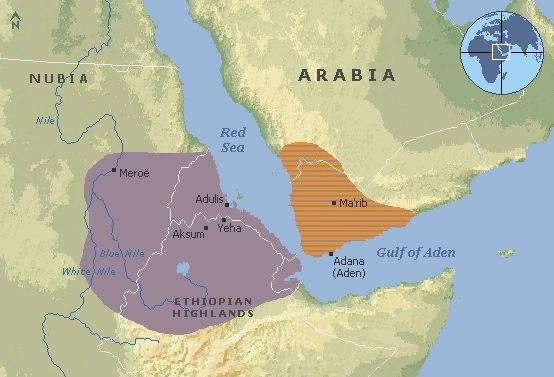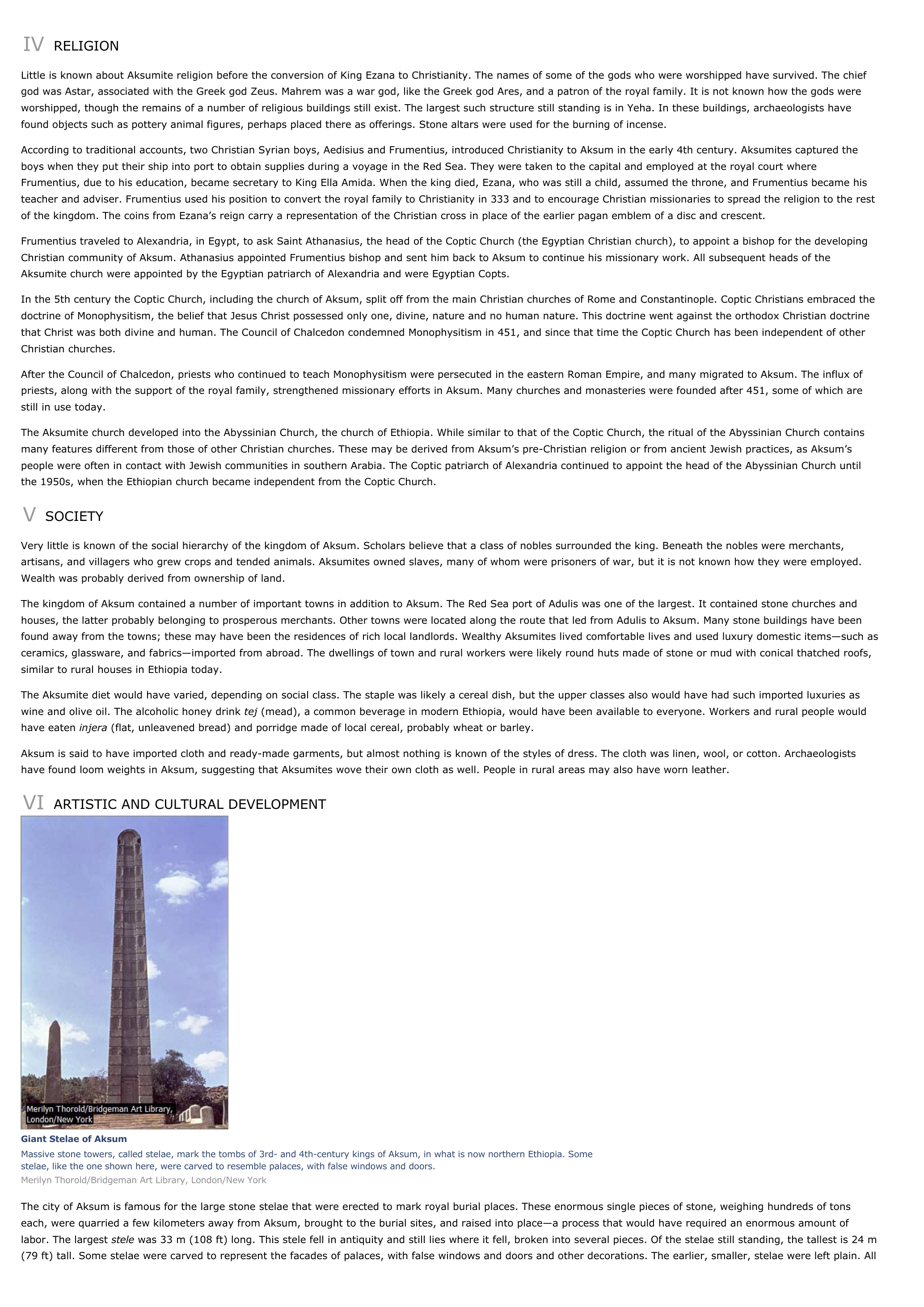Aksum - history.
Publié le 26/05/2013

Extrait du document


«
IV RELIGION
Little is known about Aksumite religion before the conversion of King Ezana to Christianity.
The names of some of the gods who were worshipped have survived.
The chiefgod was Astar, associated with the Greek god Zeus.
Mahrem was a war god, like the Greek god Ares, and a patron of the royal family.
It is not known how the gods wereworshipped, though the remains of a number of religious buildings still exist.
The largest such structure still standing is in Yeha.
In these buildings, archaeologists havefound objects such as pottery animal figures, perhaps placed there as offerings.
Stone altars were used for the burning of incense.
According to traditional accounts, two Christian Syrian boys, Aedisius and Frumentius, introduced Christianity to Aksum in the early 4th century.
Aksumites captured theboys when they put their ship into port to obtain supplies during a voyage in the Red Sea.
They were taken to the capital and employed at the royal court whereFrumentius, due to his education, became secretary to King Ella Amida.
When the king died, Ezana, who was still a child, assumed the throne, and Frumentius became histeacher and adviser.
Frumentius used his position to convert the royal family to Christianity in 333 and to encourage Christian missionaries to spread the religion to the restof the kingdom.
The coins from Ezana’s reign carry a representation of the Christian cross in place of the earlier pagan emblem of a disc and crescent.
Frumentius traveled to Alexandria, in Egypt, to ask Saint Athanasius, the head of the Coptic Church (the Egyptian Christian church), to appoint a bishop for the developingChristian community of Aksum.
Athanasius appointed Frumentius bishop and sent him back to Aksum to continue his missionary work.
All subsequent heads of theAksumite church were appointed by the Egyptian patriarch of Alexandria and were Egyptian Copts.
In the 5th century the Coptic Church, including the church of Aksum, split off from the main Christian churches of Rome and Constantinople.
Coptic Christians embraced thedoctrine of Monophysitism, the belief that Jesus Christ possessed only one, divine, nature and no human nature.
This doctrine went against the orthodox Christian doctrinethat Christ was both divine and human.
The Council of Chalcedon condemned Monophysitism in 451, and since that time the Coptic Church has been independent of otherChristian churches.
After the Council of Chalcedon, priests who continued to teach Monophysitism were persecuted in the eastern Roman Empire, and many migrated to Aksum.
The influx ofpriests, along with the support of the royal family, strengthened missionary efforts in Aksum.
Many churches and monasteries were founded after 451, some of which arestill in use today.
The Aksumite church developed into the Abyssinian Church, the church of Ethiopia.
While similar to that of the Coptic Church, the ritual of the Abyssinian Church containsmany features different from those of other Christian churches.
These may be derived from Aksum’s pre-Christian religion or from ancient Jewish practices, as Aksum’speople were often in contact with Jewish communities in southern Arabia.
The Coptic patriarch of Alexandria continued to appoint the head of the Abyssinian Church untilthe 1950s, when the Ethiopian church became independent from the Coptic Church.
V SOCIETY
Very little is known of the social hierarchy of the kingdom of Aksum.
Scholars believe that a class of nobles surrounded the king.
Beneath the nobles were merchants,artisans, and villagers who grew crops and tended animals.
Aksumites owned slaves, many of whom were prisoners of war, but it is not known how they were employed.Wealth was probably derived from ownership of land.
The kingdom of Aksum contained a number of important towns in addition to Aksum.
The Red Sea port of Adulis was one of the largest.
It contained stone churches andhouses, the latter probably belonging to prosperous merchants.
Other towns were located along the route that led from Adulis to Aksum.
Many stone buildings have beenfound away from the towns; these may have been the residences of rich local landlords.
Wealthy Aksumites lived comfortable lives and used luxury domestic items—such asceramics, glassware, and fabrics—imported from abroad.
The dwellings of town and rural workers were likely round huts made of stone or mud with conical thatched roofs,similar to rural houses in Ethiopia today.
The Aksumite diet would have varied, depending on social class.
The staple was likely a cereal dish, but the upper classes also would have had such imported luxuries aswine and olive oil.
The alcoholic honey drink tej (mead), a common beverage in modern Ethiopia, would have been available to everyone.
Workers and rural people would have eaten injera (flat, unleavened bread) and porridge made of local cereal, probably wheat or barley.
Aksum is said to have imported cloth and ready-made garments, but almost nothing is known of the styles of dress.
The cloth was linen, wool, or cotton.
Archaeologistshave found loom weights in Aksum, suggesting that Aksumites wove their own cloth as well.
People in rural areas may also have worn leather.
VI ARTISTIC AND CULTURAL DEVELOPMENT
Giant Stelae of AksumMassive stone towers, called stelae, mark the tombs of 3rd- and 4th-century kings of Aksum, in what is now northern Ethiopia.
Somestelae, like the one shown here, were carved to resemble palaces, with false windows and doors.Merilyn Thorold/Bridgeman Art Library, London/New York
The city of Aksum is famous for the large stone stelae that were erected to mark royal burial places.
These enormous single pieces of stone, weighing hundreds of tonseach, were quarried a few kilometers away from Aksum, brought to the burial sites, and raised into place—a process that would have required an enormous amount oflabor.
The largest stele was 33 m (108 ft) long.
This stele fell in antiquity and still lies where it fell, broken into several pieces.
Of the stelae still standing, the tallest is 24 m (79 ft) tall.
Some stelae were carved to represent the facades of palaces, with false windows and doors and other decorations.
The earlier, smaller, stelae were left plain.
All.
»
↓↓↓ APERÇU DU DOCUMENT ↓↓↓
Liens utiles
- Ideology and Rationality in the History of the Life Sciences
- HISTOIRE DU RÈGNE DE L'EMPEREUR CHARLES-QUINT [The History of the Reign of the Emperor Charles V].
- HISTOIRE DU MONDE [History of the World].
- GRANDISON (L') [The History of sir Charles Grandison]. (résumé)
- Robin George Collingwood, The Ides of History, 1946, Oxford University Press, 1994, p. 429 sv., trad. pers.

































